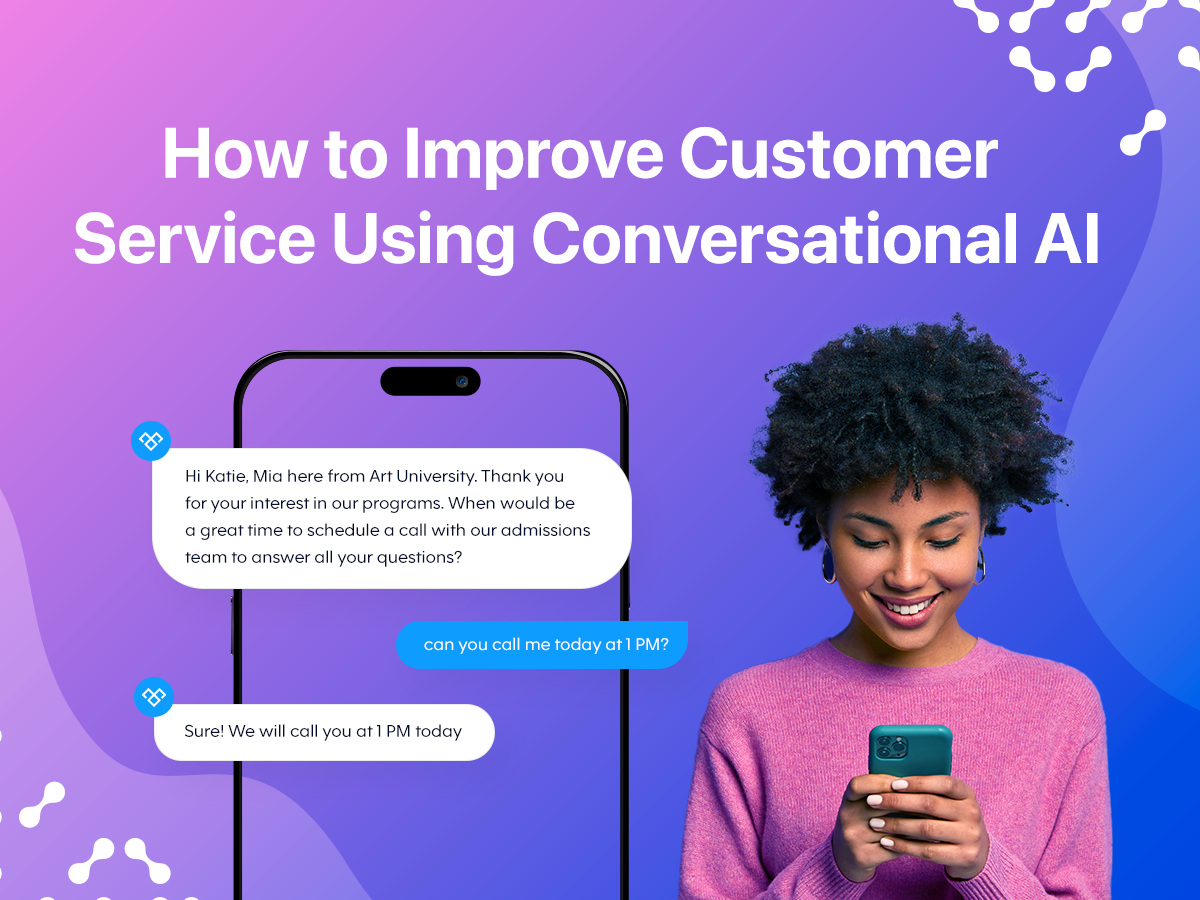How to improve customer service using Conversational AI

A customer struggling with a problem will always seek help, and now new technologies make helping them easier than ever. In the traditional chatbot days, understanding specific needs could be a roadblock. But now, with Conversational AI, it's a whole different ball game.
AI has emerged as the future of marketing, reshaping the way businesses connect with their audiences. Adapting to the twists and turns of modern business is made easier with Conversational AI. This advanced system not only understands the customer's concerns but also adapts to the evolving conversation, turning a simple query into an engaging dialogue.
Efficiency takes the spotlight as these advanced systems handle a broader range of customer queries, freeing up human agents to tackle the more intricate, high-stakes issues with ease.
Are you ready to take your customer service to the next level? Dive into our guide as we unravel the potential of Conversational AI in reshaping the customer experience.
What is Conversational AI?
In a world where AI is no longer a futuristic concept but an integral part of everyday business, Conversational AI emerges as the hero for transforming customer interactions. In fact, 95% of interactions will be powered by AI as businesses worldwide embrace its power as early as 2025.
Conversational AI orchestrates seamless dialogues between businesses and customers. Deep neural learning algorithms combined with natural language processing and understanding capabilities enable it to comprehend queries and humanize the entire conversation.
Benefits of AI-Powered Chatbots for Customer Service

Here are the benefits you could expect with Conversational AI:
- Instant Responses: AI-powered chatbots ensure your customers receive lightning-fast responses to their queries, eliminating the wait time and enhancing overall satisfaction.
- Lead Generation Assistance: These intelligent chatbots aren't just problem-solvers. They're considered as the new lead magnet, adding an invaluable dimension to customer interactions.
- Efficient Handling of Customer Interactions: With the ability to handle a substantial volume of customer queries, Conversational AI streamlines processes, leaving your human agents free to tackle more complex issues.
- 24/7 Availability: AI-powered bots ensure round-the-clock availability, catering to customers in different time zones or those who prefer seeking assistance outside regular business hours. This continuous accessibility enhances customer satisfaction and loyalty.
- Scalability: Effortlessly scale to handle a high volume of customer queries without getting clogged up. Whether it's during a product launch, a marketing campaign, or a seasonal peak, chatbots ensure that customer service remains efficient and responsive.
- Data Collection and Analysis: The data collected by AI can be analyzed to identify trends, preferences, and areas for improvement in customer service. The insights gained can inform strategic decision-making and enhance overall business operations.
- Integration with Other Systems: AI-powered chatbots can seamlessly integrate with other business systems, such as CRM software and e-commerce platforms. This integration ensures a cohesive flow of information, allowing chatbots to access relevant customer data and provide more personalized assistance.
As businesses strive to enhance operations and create richer customer interactions, AI-powered chatbots stand at the forefront, shaping the future of customer engagement.
Understanding Human Language and Natural Language Processing
Once confined to science fiction, human language understanding has now become commonplace with AI, reaching far beyond personal use and into the strategic operations of businesses.
As AI seamlessly integrates into our daily lives, the question is no longer whether it understands human language but rather how it navigates the complexities of communication.
What is Natural Language Processing?

The transformation brought about by AI is nothing short of remarkable. Today, businesses harness the power of Natural Language Processing (NLP) to handle the complexity of human language. The Guardian even wrote an article purely with AI, and this was made possible with NLP.
NLP is a subfield of AI that focuses on the interaction between computers and humans through natural language. The goal of NLP is to enable computers to understand, interpret, and generate human language in a way that is both meaningful and contextually relevant.
This involves the development of algorithms and computational models that can process and analyze large amounts of natural language data. NLP encompasses a range of tasks, including speech recognition, language translation, sentiment analysis, and text generation.
Through the use of machine learning and linguistic rules, NLP systems attempt to close the gap between human communication and computer understanding, allowing for more intuitive and efficient interactions between humans and machines.
How to Implement Natural Language Understanding in Customer Service Operations
Natural Language Understanding (NLU) is the engine that enables machines to comprehend and interpret human language in a way that goes beyond simple translations.
In customer service, knowing how to implement NLU means empowering systems to not only recognize the words customers use but also grasp the nuances, context, and intent behind their queries.
The steps to implement NLU in customer service operations are as follows:
- Select the Right NLU Solution: Begin by choosing an NLU solution that aligns with the specific needs of your customer service operations. Look for platforms that offer robust language processing capabilities and can seamlessly integrate with your existing systems.
- Integrate with CRM Systems: To maximize the impact of NLU, integrate it with Customer Relationship Management (CRM) systems. This ensures that customer interactions are not isolated events but part of a broader understanding of each customer's history, preferences, and needs.
- Train the NLU Model: Tailor the NLU model to your business context by training it with relevant data. This includes customer interactions, historical queries, and industry-specific language. The more finely tuned the model, the more accurately it can understand and respond to customer queries.
- Define Key Use Cases: Whether it's handling product inquiries, resolving complaints, or providing technical support, align the implementation with specific objectives to ensure targeted and effective outcomes.
- Continuous Monitoring and Optimization: NLU is not a one-time implementation. This is an ongoing process. Continuously monitor its performance, gather feedback, and optimize the model based on real-world interactions. This continuous approach ensures that the system evolves with the changing dynamics of customer queries and industry trends.
- Multichannel Integration: Extend the reach of NLU by integrating it across various customer communication channels. Whether customers reach out via chat, email, or voice, a consistent NLU experience ensures a seamless and unified customer service approach.
Automated messages with the power of NLU excel in handling routine inquiries, leaving human support to address more complex concerns without overloading the team. Balance is key, using technology to enhance customer service while maintaining the human touch when it matters most.
Streamlining Repetitive Tasks with AI-Enabled Chatbots
Let's delve into how AI-enabled chatbots revolutionize customer service by automating common queries and providing relevant, personalized responses, setting the stage for a new era of customer-centric interactions.
Automating Common Customer Queries
By leveraging AI, businesses can go beyond scripted responses, asking the next best question and performing the next best action based on historical and real-time context.
This approach combines situational know-how with compliance requirements, ensuring that each interaction is not just automated but also thoughtful and tailored to the specific needs of the customer.
Providing Relevant Responses and Personalized Experiences

With customer data and an understanding of their behavior and preferences, AI-powered bots go beyond conventional, providing tailored interactions that feel like bespoke solutions. The introduction of cognitive AI systems takes this to the next level, proactively addressing customer needs and comprehending the context of conversations.
An automated texting service like Meera brings this vision to life seamlessly into your business operations, delivering AI efficiency while maintaining the crucial element of human-like interaction. Meera also lets you cultivate conversations, unlike cold calling. Meera lets you transition smoothly to a call anytime and at everyone's convenience.
Enhancing Complex Issues with Human Agents
Human agents play a pivotal role in customer service, where excellence is not just a goal but a standard. Their expertise extends beyond the transactional – they specialize in crafting exceptional customer experiences, tackling complex issues, and ensuring customer satisfaction both pre- and post-purchase.
Acting as the face of the organization, customer service teams are the frontline when assistance is sought, handling everything from product queries to intricate problem-solving.
This matters even for retention, with 82% of customers saying they're more likely to make a repeat purchase if they get value from the service encounter.
With the integration of AI, the repetitive tasks that often bog down efficiency are seamlessly managed, allowing human agents to focus their expertise on resolving complex issues that truly matter.
Integrating AI and Human Intelligence in the Customer Service Team
A key component of elevating customer service is the successful integration of AI and human intelligence. Modern Conversational AI solutions and intelligent AI texting platforms like Meera seamlessly integrated with existing CRM systems offer a powerful synergy. This integration doesn't replace human agents but enhances their capabilities.
By automating routine tasks and providing instant access to relevant customer information, AI empowers human agents to deliver more personalized, efficient, and empathetic support. This creates a winning combination that resonates with today's discerning customers.
Improving Response Times and Quality of Support Conversations
In the race for exceptional customer service, response times and the quality of support conversations are crucial. Conversational AI for customer service emerges as the game-changer, significantly reducing support volume and improving customer wait times.
AI-driven chatbots, powerful in handling routine inquiries, allow human support teams to divert their energy towards more complex issues, resulting in heightened customer satisfaction.
Human agents in customer service excel at managing complex and nuanced issues that demand critical thinking and empathy, such as handling complaints, resolving disputes, and addressing escalated queries, among others.
The dynamic duo of AI and human intelligence ensures not just prompt responses but meaningful, high-quality interactions that leave a lasting positive impression on customers, reinforcing their loyalty to the brand.
Measuring the Success of Conversational AI in Customer Service
AI, with its unparalleled data-gathering capabilities, offers insights that can drive meaningful improvements.
This journey of success measurement is guided by the assessment of Key Performance Indicators (KPIs) for chatbot efficacy, ensuring that the impact on customer satisfaction and brand affinity is not just a hunch but a quantifiable reality.
Assessing Key Performance Indicators (KPIs) for Chatbot Success

KPIs serve as a guide for determining the success of AI-driven chatbots in customer service. The following KPIs are notable for driving success:
- Response Time: The speed at which the AI chatbot responds to customer queries, contributing to a seamless and efficient customer experience.
- Resolution Time: The time it takes for the AI chatbot to successfully address and resolve customer issues, indicating its effectiveness in providing solutions.
- User Interactions: A measure of the engagement levels between customers and the AI chatbot, reflecting the effectiveness of the chatbot in maintaining user interest.
- Conversion Rates: The percentage of interactions that result in a desired outcome, such as a successful query resolution or a completed transaction.
Evaluating the effectiveness of Conversational AI in understanding and resolving customer queries, tracking the conversion rates, and assessing the overall customer experience are pivotal KPIs.
Measuring these indicators effectively can greatly help businesses fine-tune their AI chatbot's performance and strategically enhance customer service.
Tracking Changes in Customer Satisfaction Rates Over Time
Understanding the impact of Conversational AI on customer satisfaction requires a nuanced approach. Tracking changes in customer satisfaction rates over time involves analyzing metrics directly influenced by the implementation of Conversational AI.
Businesses can assess the true impact of Conversational AI on the customer experience by comparing the reduction in customer effort and wait times with the increase in customer satisfaction.
- Customer Effort Score (CES): A metric measuring the ease with which customers can get their queries resolved, showcasing the level of convenience provided by Conversational AI.
- Customer Satisfaction (CSAT): An indicator of customer contentment based on their experience with Conversational AI, offering insights into overall satisfaction levels.
By continuously monitoring and adapting strategies based on these KPIs, businesses can not only optimize their AI chatbot's performance but also foster a customer-focused strategy, ultimately leading to improved customer satisfaction and strengthened brand affinity.
In Conclusion
The potential of Conversational AI to redefine the customer experience cannot be overstated. From automating routine tasks to providing personalized interactions, AI-driven chatbots are the secret sauce for businesses aiming to elevate their customer service experience.
An automated texting platform can seamlessly weave this innovative technology into business operations. This platform serves as the bridge, effortlessly connecting Conversational AI with your business operations.
Coupled with Conversational AI, businesses are able to unlock a new era of customer service excellence.
A programmer by trade, Nick Saraev is a freelance writer and entrepreneur with a penchant for helping people achieve their business goals. He's been featured on Popular Mechanics & and Apple News and has founded several successful companies in e-commerce, marketing, and artificial intelligence. When he's not working on his latest project, you can find him hiking or painting.


.png?width=512&height=512&name=guru%20(1).png)

.png?width=199&height=109&name=salesforce-logo1-removebg-preview%20(1).png)


.webp?width=716&height=569&name=banner-img%20(1).webp)



